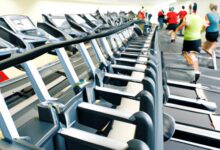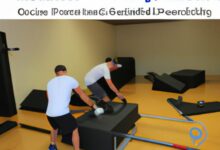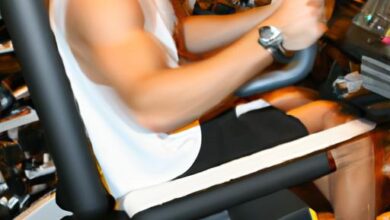The Power of Revit Gym Equipment: Transforming Design and Visualization
Discover how revit gym equipment revolutionizes the design and visualization process. Explore the benefits of creating custom gym equipment families, accessing an extensive library of models, and simulating performance in different scenarios. Ensure compatibility and integration with other building systems while streamlining the design to documentation process. At Goldsport, we specialize in providing comprehensive solutions for gym equipment projects using Revit. Elevate your fitness journey with the power of Revit gym equipment.

| Key Takeaways |
|---|
| Revit is a powerful software for designing and visualizing gym equipment. |
| Users can create custom gym equipment families in Revit to suit their specific needs. |
| There are various online platforms and libraries where users can download gym equipment models for Revit. |
| Revit allows users to simulate the performance and functionality of gym equipment in different scenarios. |
| Users can test the compatibility and integration of gym equipment with other building systems using Revit. |
| Revit streamlines the design and documentation process for gym equipment projects. |
The Power of Revit: Transforming Gym Equipment Design and Visualization
Revolutionizing Gym Equipment Design with Revit
Revit, the powerful software for building information modeling (BIM), has transformed the way gym equipment is designed and visualized. With its advanced features and capabilities, Revit allows architects, engineers, and contractors to create realistic and detailed models of gym equipment. This enables them to accurately visualize how the equipment will look and function within a gym space, facilitating better design decisions and enhanced client communication. By utilizing Revit, designers can bring their creative ideas to life and ensure that the gym equipment perfectly fits the desired aesthetic and functionality.
Enhancing Visualization for Better Client Communication
One of the key advantages of using Revit for gym equipment design is its ability to enhance visualization. With Revit’s 3D modeling capabilities, designers can create lifelike representations of the equipment, allowing clients to fully understand and visualize the final result. This helps in building trust and confidence between designers and clients, as they can collaborate effectively and make informed decisions throughout the design process. Whether it’s showcasing a new line of fitness machines or designing a complete gym layout, Revit empowers designers to present their ideas in a visually compelling manner.
Efficient Iteration and Design Refinement
Revit’s parametric modeling approach enables efficient iteration and design refinement for gym equipment. Designers can easily modify the dimensions, materials, and components of the equipment within the Revit model, allowing for quick adjustments and improvements. This iterative process helps in fine-tuning the design to meet specific requirements, whether it’s optimizing ergonomics, improving functionality, or incorporating branding elements. By utilizing Revit’s flexibility, designers can explore multiple design options and select the most suitable one that aligns with their client’s vision and goals.
Overall, Revit’s transformative capabilities in gym equipment design and visualization empower designers to create stunning and functional gym spaces. With enhanced visualization, efficient iteration, and seamless client communication, Revit proves to be an invaluable tool in the gym equipment design process.
https://www.youtube.com/watch?v=BYBNjs1YuFk
Creating Custom Gym Equipment Families in Revit: Tailoring Designs to Fit Your Needs
Designing Gym Equipment That Matches Your Vision
Revit offers architects, engineers, and contractors the flexibility to create custom gym equipment families that align with their specific design requirements. With Revit’s robust modeling capabilities, you can tailor the dimensions, shapes, and features of gym equipment to match your vision. Whether you need a unique bench design or a specialized weight machine, Revit empowers you to bring your ideas to life and ensure that the gym equipment perfectly fits your space and aesthetic preferences.
Enhancing Functionality and Performance
When designing custom gym equipment families in Revit, you have the opportunity to optimize their functionality and performance. By incorporating specific features and adjustments, you can enhance the usability and effectiveness of the equipment. For example, you can customize the range of motion for weight machines or add ergonomic elements to improve user comfort. With Revit’s parametric modeling capabilities, you can easily adjust these parameters and fine-tune the gym equipment to meet the unique needs of your clients or end-users.
Seamless Integration with Building Systems
Revit’s ability to create custom gym equipment families goes beyond aesthetics and functionality. It also enables seamless integration with other building systems. When designing gym equipment in Revit, you can ensure that it aligns with the overall building structure, electrical systems, plumbing, and more. This integration ensures that the gym equipment is properly coordinated within the larger context of the facility, optimizing safety, efficiency, and maintenance. By leveraging Revit’s interoperability features, you can create a cohesive and well-integrated gym space that meets all the necessary requirements.
Internal Link: To learn more about the importance of gym equipment maintenance and cleanliness, check out our article on Please Wipe Down Gym Equipment Sign: Promoting Cleanliness and Hygiene at the Gym.

Exploring the Extensive Library of Revit Gym Equipment Models: A World of Possibilities
Accessing a Vast Collection of Gym Equipment Models
Revit offers users an extensive library of gym equipment models that can be easily accessed and utilized in their projects. With just a few clicks, architects, engineers, and contractors can explore a wide range of gym equipment options from different brands, categories, and specifications. This vast collection provides a world of possibilities for designing and visualizing fitness spaces that cater to specific needs and preferences.
Choosing the Right Gym Equipment for Your Project
Within the library of Revit gym equipment models, users can find everything they need to create a comprehensive fitness facility. From treadmills and ellipticals to weight machines and benches, the options are diverse and cater to various fitness goals. Whether it’s a commercial gym or a residential fitness space, Revit’s library ensures that users can find the right equipment to meet their project requirements.
Seamless Integration with Other Design Elements
Revit’s gym equipment models are designed to seamlessly integrate with other design elements in the BIM environment. This integration allows users to accurately visualize how the gym equipment fits within the overall layout of the space. Architects and designers can ensure proper spacing, circulation, and functionality by placing the gym equipment models within their Revit projects. This level of integration enhances the overall design process and helps create cohesive fitness spaces.
Enhancing Collaboration and Communication
The extensive library of Revit gym equipment models also facilitates collaboration and communication among project stakeholders. By using these models, architects and designers can effectively communicate their design intent to clients, contractors, and other team members. The realistic representation of the gym equipment models helps everyone involved in the project visualize the final outcome, enabling better decision-making and ensuring that the design meets the client’s expectations.
Overall, the extensive library of Revit gym equipment models opens up a world of possibilities for architects, engineers, and contractors in the fitness industry. With a vast collection of options to choose from, seamless integration with other design elements, and enhanced collaboration capabilities, Revit empowers professionals to create innovative and functional fitness spaces that cater to the needs of their clients.

Simulating Performance and Functionality: Testing Gym Equipment in Different Scenarios
Enhancing Design Accuracy and Efficiency
Revit offers a powerful platform for simulating the performance and functionality of gym equipment in various scenarios. By utilizing Revit’s simulation capabilities, designers can ensure that their gym equipment models accurately represent real-world behavior. This enables them to identify any potential design flaws or issues before the equipment is physically constructed, saving time and resources in the long run. With the ability to test different scenarios, such as user interactions, weight resistance, and movement patterns, Revit empowers designers to optimize the performance and functionality of gym equipment.
Optimizing User Experience and Safety
When it comes to gym equipment, user experience and safety are paramount. Revit allows designers to simulate how users will interact with the equipment, ensuring that it meets ergonomic standards and provides a comfortable and safe workout experience. By testing different scenarios, such as adjusting seat heights, handlebar positions, or weight stack configurations, designers can fine-tune the equipment to cater to a wide range of users. This helps create a gym environment that promotes inclusivity and reduces the risk of injuries.
Integration with Building Systems
Gym equipment doesn’t exist in isolation; it needs to seamlessly integrate with other building systems. Revit’s simulation capabilities extend beyond the equipment itself, allowing designers to test its compatibility and interoperability with other building elements. For example, designers can simulate how the gym equipment interacts with the flooring, lighting, ventilation, and electrical systems. This ensures that all components work together harmoniously, creating a cohesive and functional gym space.
Realistic Visualization and Presentation
Revit’s simulation features go beyond functionality testing; they also enable designers to create realistic visualizations of gym equipment in different scenarios. This is particularly useful when presenting designs to clients or stakeholders, as it allows them to visualize how the equipment will look and function in the final space. By providing accurate and immersive visual representations, Revit helps designers effectively communicate their ideas and gain valuable feedback, ultimately leading to better-informed design decisions.
Internal link: To learn more about gym equipment and its role in creating a comprehensive workout space, refer to our article on Gym Equipment List PDF: A Comprehensive Guide to Building Your Perfect Workout Space.

5. Ensuring Compatibility and Integration: Revit’s Role in Building Systems Coordination
Efficient Coordination of Gym Equipment with Other Building Systems
Revit plays a crucial role in ensuring the seamless integration and coordination of gym equipment with other building systems. Whether it’s the structural, mechanical, electrical, plumbing, or fire protection systems, Revit allows designers and engineers to visualize how the gym equipment fits within the overall building layout. By creating a digital model of the gym equipment and its surrounding environment, potential clashes or conflicts with other systems can be identified and resolved early in the design process.
Optimizing Space and Layout Planning
Revit’s powerful features enable users to optimize space and layout planning for gym equipment. Designers can accurately position each piece of equipment within the available space, considering factors such as clearances, accessibility, and safety requirements. With Revit’s parametric capabilities, adjustments can be made easily to accommodate changes in equipment selection or client preferences. This ensures that the gym layout is efficient and maximizes the use of available space.
Enhancing Safety and Accessibility
Safety and accessibility are paramount considerations when designing a gym space. Revit allows designers to evaluate the impact of gym equipment on factors such as emergency exits, evacuation routes, and accessibility for individuals with disabilities. By simulating different scenarios and analyzing data within the Revit model, potential hazards or limitations can be identified and addressed proactively. This ensures that the gym space is safe and inclusive for all users.
Seamless Integration of Body Masters Gym Equipment
When working with Body Masters gym equipment, Revit offers a seamless integration process. Designers can access a comprehensive library of Body Masters gym equipment models within Revit, making it easier to incorporate these specific products into their designs. This integration ensures that the gym equipment is accurately represented in the digital model and facilitates efficient coordination with other building systems.
Collaborative Design and Documentation
Revit promotes collaborative design and documentation among architects, engineers, contractors, and other stakeholders involved in the gym equipment project. Through shared access to the Revit model, team members can contribute their expertise, make necessary adjustments, and communicate effectively to ensure that the gym equipment aligns with the overall building design. This collaborative approach streamlines the coordination process and leads to more accurate documentation for construction and future maintenance purposes.
By leveraging Revit’s capabilities for building systems coordination, designers can ensure that gym equipment seamlessly integrates with other building components, optimize space planning, enhance safety and accessibility, and facilitate collaborative design and documentation. This comprehensive approach enables a smooth and efficient workflow throughout the entire gym equipment project, resulting in a well-coordinated fitness space that meets the needs of its users.

From Design to Documentation: Streamlining the Process with Revit for Gym Equipment Projects
Revit offers a streamlined process for gym equipment projects, allowing designers to seamlessly transition from the initial design phase to documentation. With Revit’s comprehensive tools and features, designers can create accurate and detailed models of gym equipment, ensuring that every aspect is captured. From the placement of machines to the arrangement of accessories, Revit enables designers to visualize the final layout and make necessary adjustments. This level of precision not only enhances the overall design process but also facilitates effective communication with clients and stakeholders. Additionally, Revit’s documentation capabilities allow designers to generate schedules, quantities, costs, and other essential information, making it easier to manage and track project progress. By utilizing Revit for gym equipment projects, designers can streamline their workflow, improve efficiency, and deliver high-quality results.
Efficient Design Process
Revit streamlines the design process by providing a user-friendly interface and a wide range of tools specifically tailored for gym equipment projects. Designers can easily create custom families and components, ensuring that each piece of equipment is accurately represented in the model. This level of customization allows for precise placement and arrangement, optimizing the functionality and aesthetics of the gym space.
Improved Collaboration
Revit’s collaborative features enable seamless communication and coordination among team members involved in the gym equipment project. Designers, architects, engineers, and contractors can work together in real-time, making necessary adjustments and ensuring that all aspects of the design are aligned. This collaborative approach minimizes errors and discrepancies, resulting in a more efficient and cohesive project.
Accurate Documentation
Revit’s documentation capabilities are invaluable for gym equipment projects. Designers can generate schedules that detail the quantity, size, and specifications of each piece of equipment. This information is crucial for procurement and installation purposes, ensuring that the right equipment is ordered and properly installed. Additionally, Revit allows for the generation of cost estimates, facilitating budgeting and financial planning for the project.
By streamlining the process from design to documentation, Revit empowers designers to efficiently manage gym equipment projects. With its user-friendly interface, collaborative features, and accurate documentation capabilities, Revit enhances the overall workflow and ensures the successful completion of gym equipment projects.





